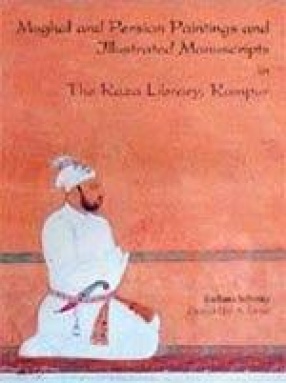Although the Study of painting under the Great Mughals is one of the most popular topics of Indian art historical research, scant attention has been given to the continuation of this tradition – the paintings and illustrated manuscripts produced at the Delhi court and various regional schools from the reign Bahadur Shah I in 1707 to the end of the reign of Bahadur Shah Zafar in 1858. During this period, the government at Delhi became weaker with multiple invasions by the Persian and Afghan armies, and attacks by Rohilla, Maratha, and Jat forces. Court artists fled Delhi to the safety of new eastern capitals, at Lucknow or Faizabad in Avadh or Murshidabad in Bengal, and local schools with highly individualistic styles came into their own. Hovering over these schools of painting was the influence of patrons from the East India Company. This Marg volume addresses several important themes of the era: the development of the styles of major artists, such as Chitarman, Dip Chand, and Imam Bakhsh, and their influences on later Mughal painting; the proliferation of regional styles during these years; and finally offered are new appraisals of the European contribution to Indian art of these 150 years. This Marg issue is resplendent with colour and black-and-white illustrations of ‘paintings in Delhi and the regional courts in the 18th and 19th centuries’ which, incidentally, is the sub-heading of the book. One of the most impressive colour portraits of the Avadh school is displayed on page two of the volume, and features John Wombwell, a paymaster and auditor general to the Nawab’s troops under British command. He sits smoking a hooka and gazing pensively out of an open door, while behind him an attendant waves a morchhal. This remarkable picture is reproduced in black-and-white once again within the book. It is the understanding of this art and its patrons in the transitional period between waning Mughal power and a rising British empire that the book has devoted its interest and scholarship. The English first started coming to Indian artists to paint subjects of interest to themselves in the second half of the 18th century. Today this type of work is called Company Art, and it includes some 300 natural history drawings made in colour in Kolkata. One exquisite example in the book is of an Indian blue jay bird. Other essays in the book include one on ‘Articulating a Life, in Words and Pictures’. It is sub-titled, ‘Begum Samru and The Ornament of Histories’ and is written by Aditya Behl of the University of Pennsylvania.

After The Great Mughals: Painting in Delhi and The Regional Courts in the 18th and 19th Centuries
$101.70
$113.00
In stock
Free & Quick Delivery Worldwide
All orders amounting to US$ 50 or more qualify for Free Delivery Worldwide. For orders less than US$ 50, we offer Standard Delivery at $14 per book.
ABOUT THE AUTHOR Barbara Schmitz
Barbara Schmitz received her Ph.D. from The Institute of Fine Arts, New York University in 1981. She is the author of three catalogues of Islamic paintings: Islamic Manuscripts in The New York Public Library (New York, 1992); Islamic and Indian Manuscripts and Paintings in The Pierpont Morgan Library (New York, 1996); and with Z.A. Desai, Mughal and Persian Painting and Illustrated Manuscripts in the Raza Library, Rampur (New Delhi, 2002). She has also contributed articles to Encyclopaedia Iranica and journals. Her interest in later Indian painting was supported by a Fulbright research grant to India in 1992-93.
ABOUT THE AUTHOR J P Losty
J.P. Losty is Head of the Prints, Drawings, and Photographs section of the Oriental and India Office Collections of the British Library, London. He is the author of The Art of the Book in India (1982); his many publications cover a wide range of subjects from medieval Indian painting to the Company schools. He is currently working on a new edition, from the original manuscripts, of the Indian journals of William Daniell.
ABOUT THE AUTHOR Terence McInerney
Terence McInerney is an independent scholar based in New York. He has written a number of articles on the subject of Indian painting, and contributed to two recent publications: Devi: the Great Goddess (edited by Vidya Dehejia, 1999) and Intimate Worlds: Indian Paintings from the Alvin O. Bellak Collection (edited by Darielle Mason, 2001).
reviews
0 in total
Review by Anonymous

After The Great Mughals: Painting in Delhi and The Regional Courts in the 18th and 19th Centuries
Be the first to review “After The Great Mughals: Painting in Delhi and The Regional Courts in the 18th and 19th Centuries” Cancel reply
You must be logged in to post a review.
Bibliographic information
Title
After The Great Mughals: Painting in Delhi and The Regional Courts in the 18th and 19th Centuries
Author
Edition
1st ed.
Publisher
ISBN
8185026564
Length
viii+168p., Plates; Notes; Index.
Subjects
more by Barbara Schmitz see more
Mughal and Persian Paintings and Illustrated Manuscripts in The Raza Library, Rampur
During the 19th century and ...
$180.00
$200.00
more by J P Losty see more
Indian Paintings of the British Period in the Jagdish and Kamla Mittal Museum of Indian Art
This exceptionally ...
$134.78
$149.75
Picturesque Views of India: Sita Ram: Lord Hastings’s Journey from Calcutta to the Punjab, 1814-15
Lord Hastings’s ...
$124.20
$138.00
similar bookssee more
Bombay: The Cities Within
$190.80
$212.00
Religion, Tradition and Ideology: Pre-Colonial South India
The volume is a collection ...
$88.20
$98.00








There are no reviews yet.